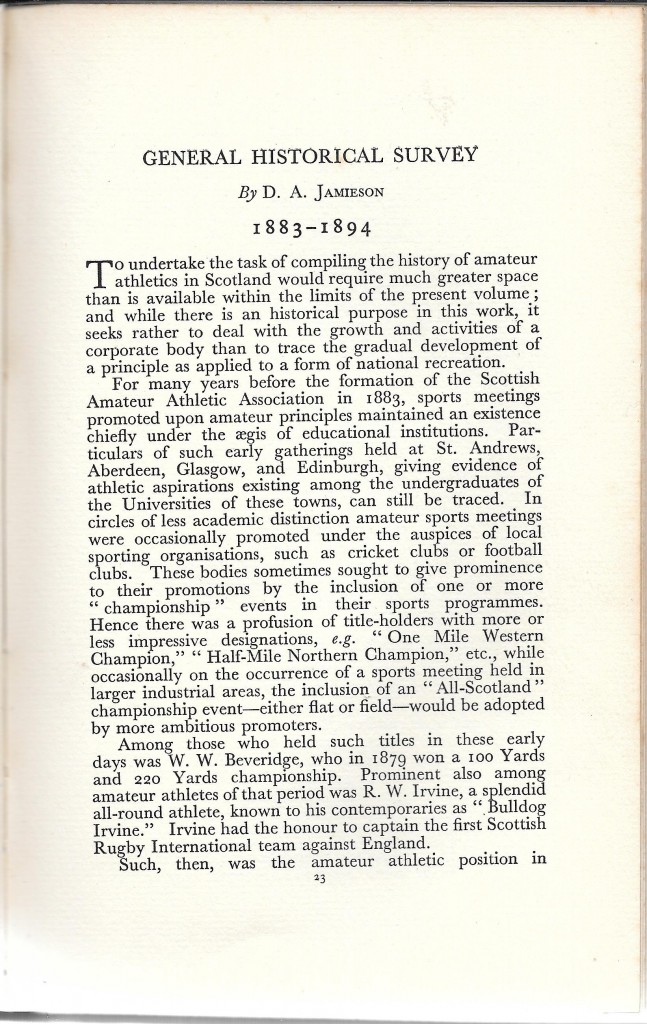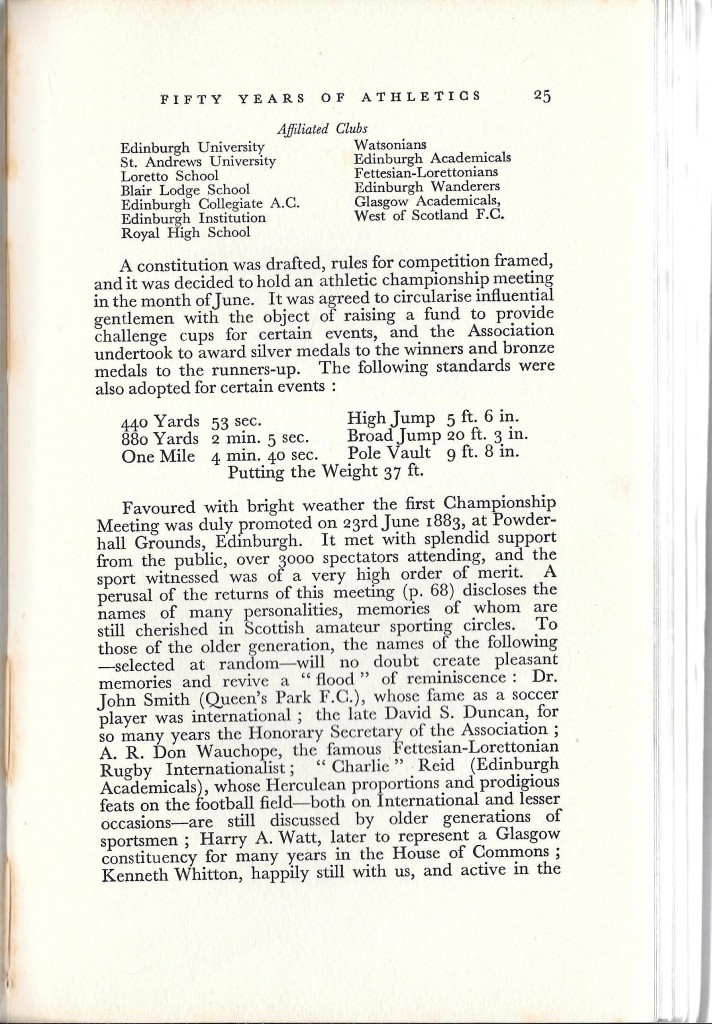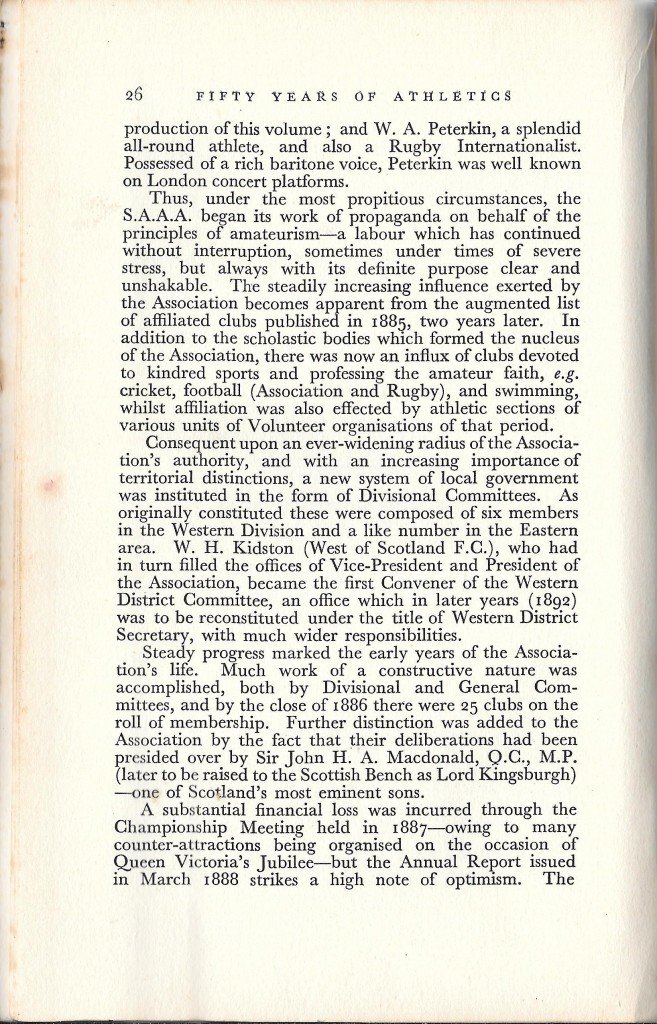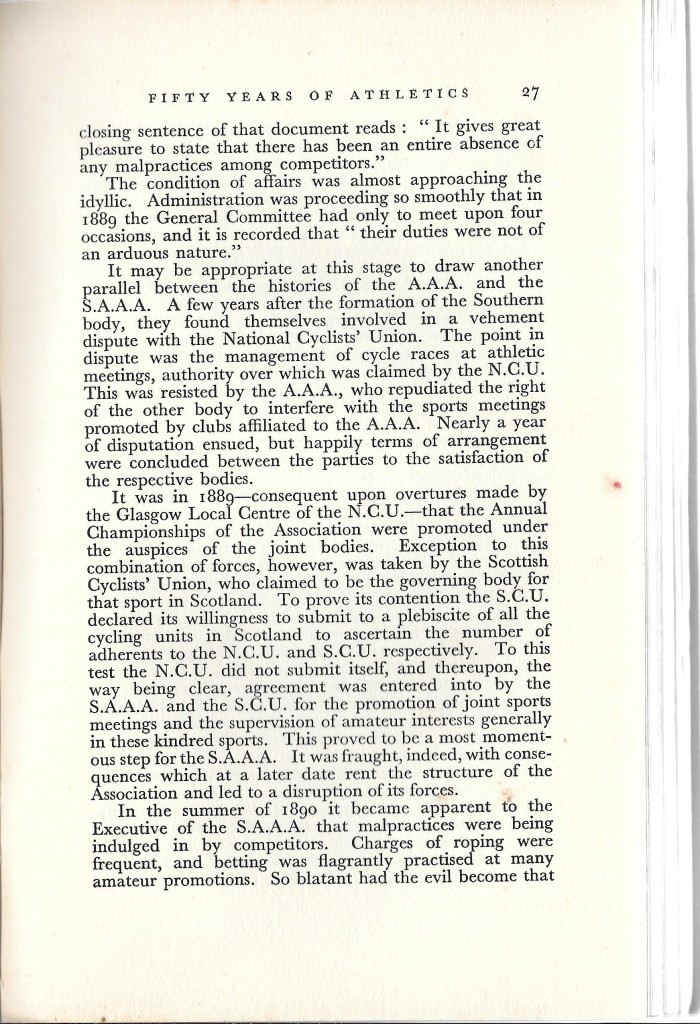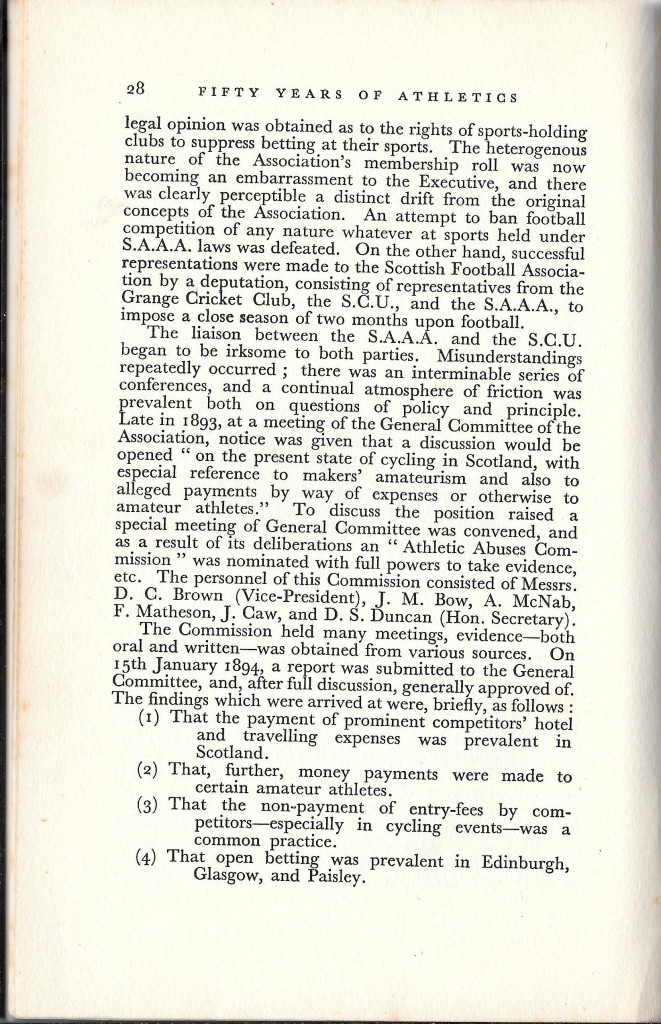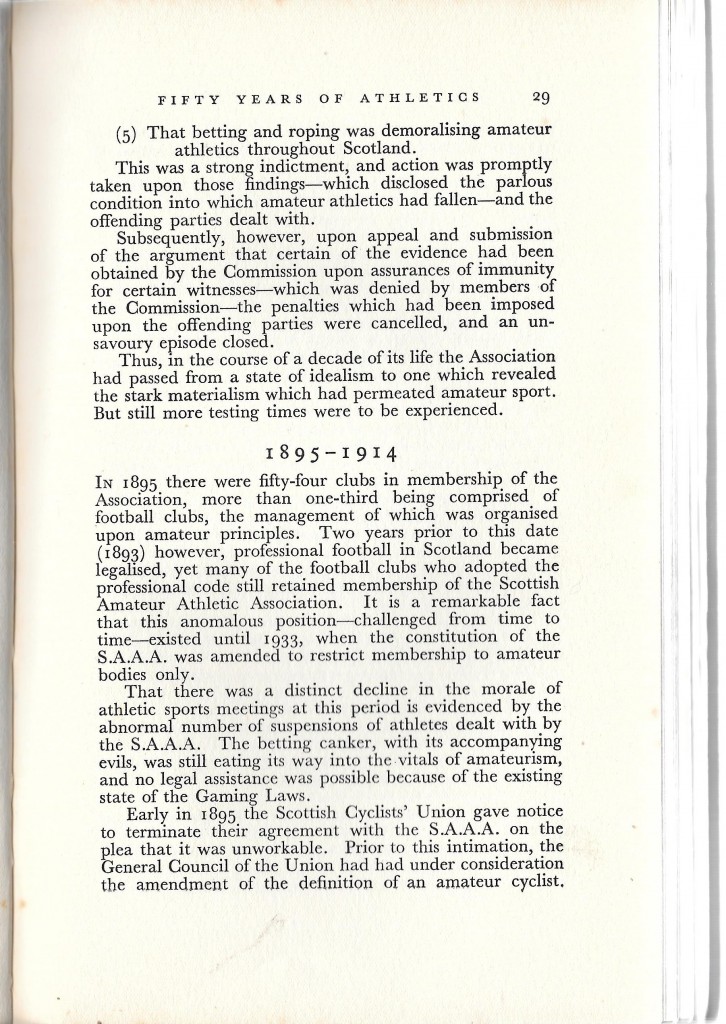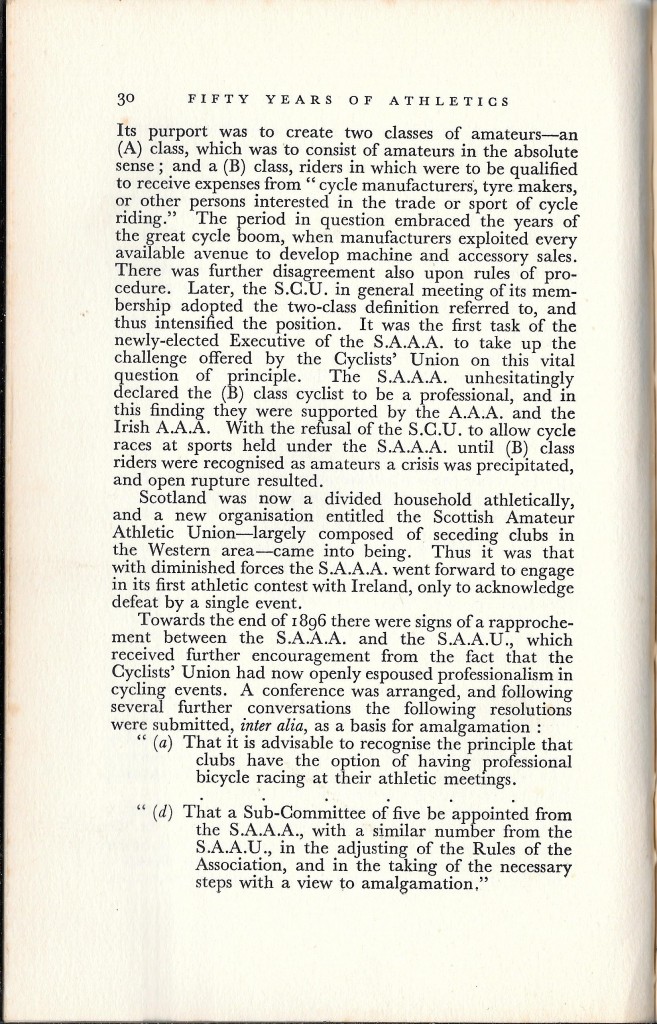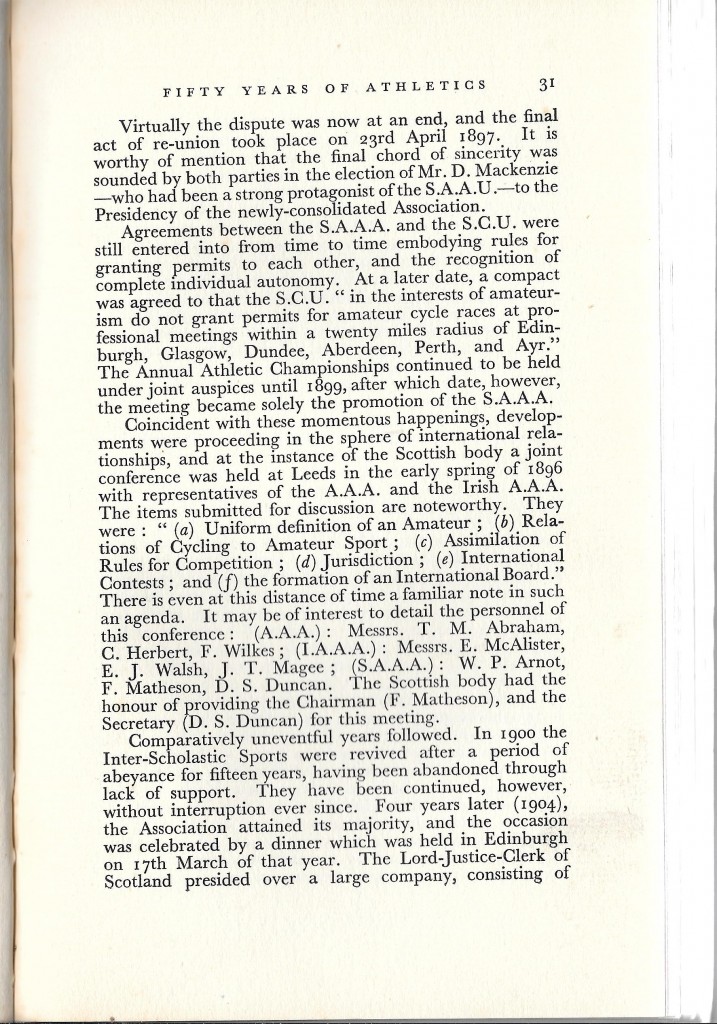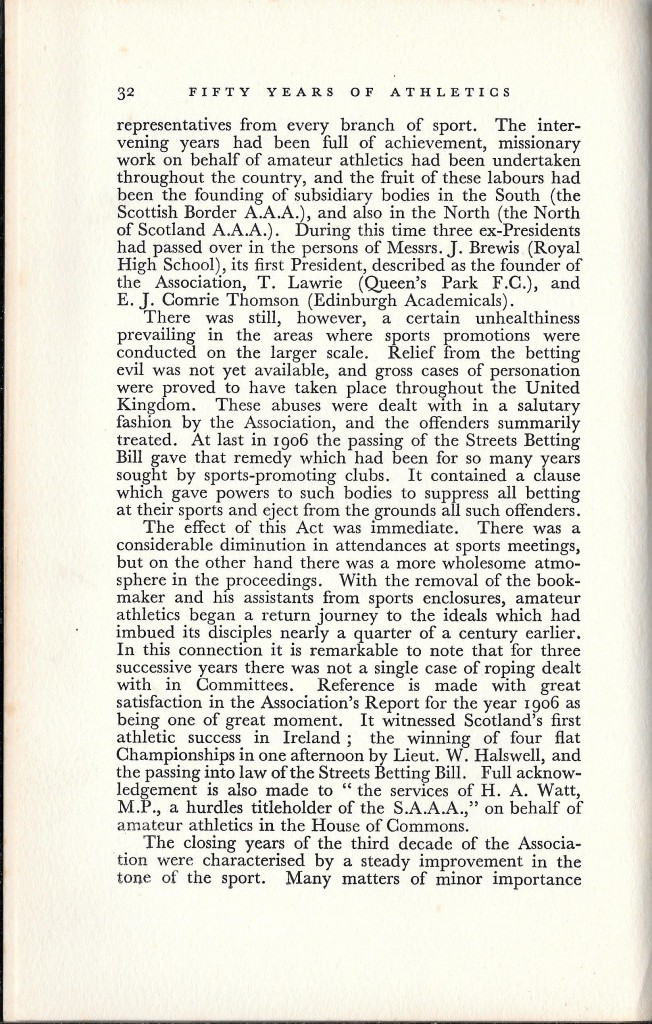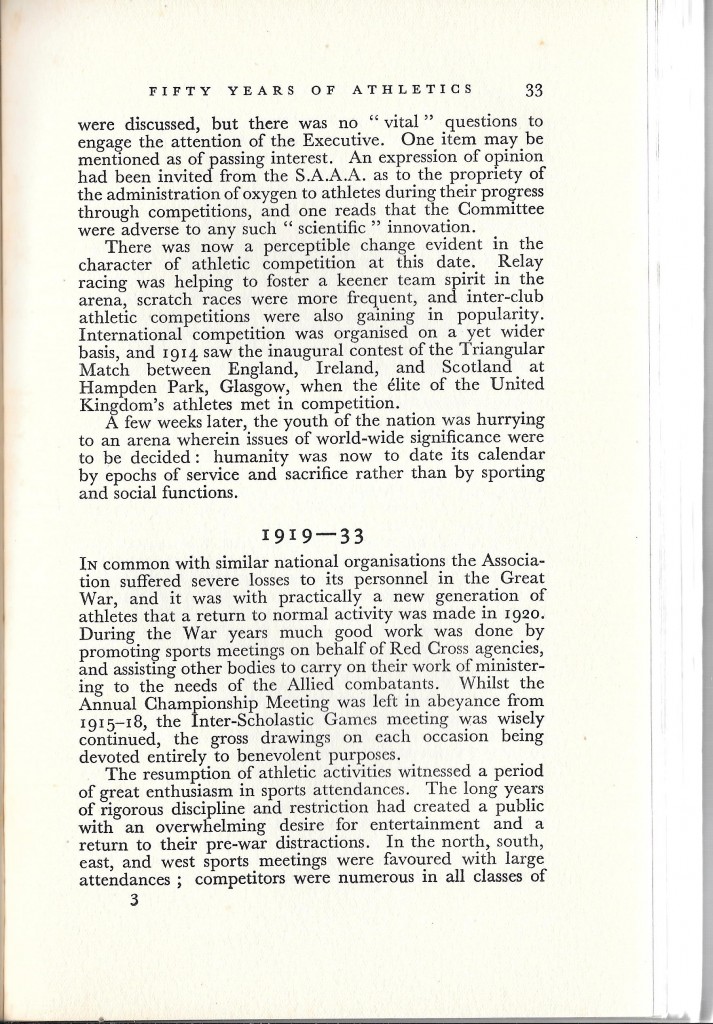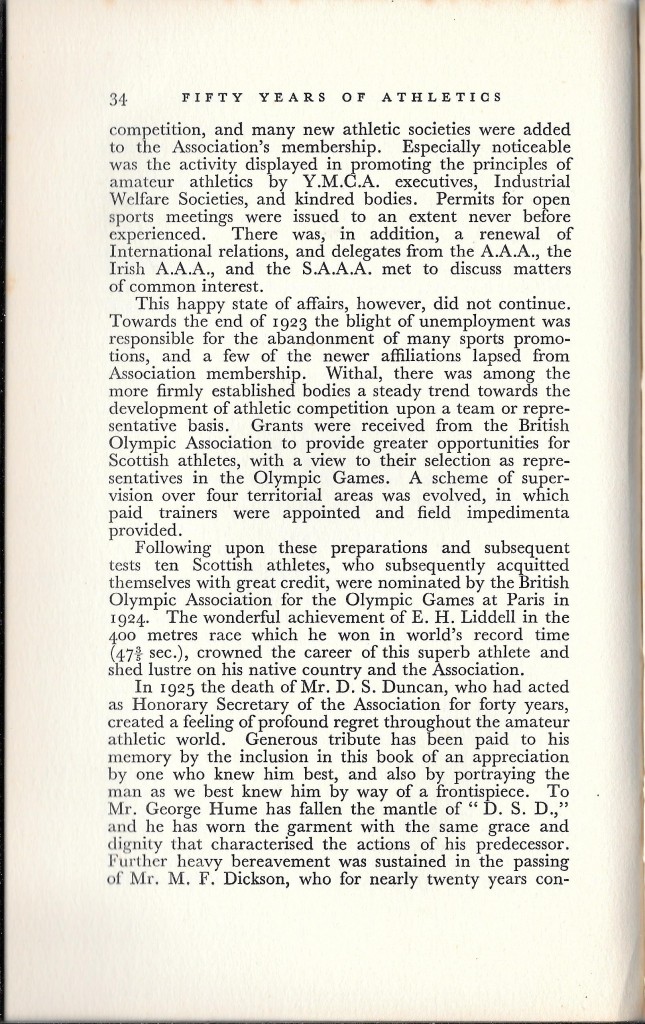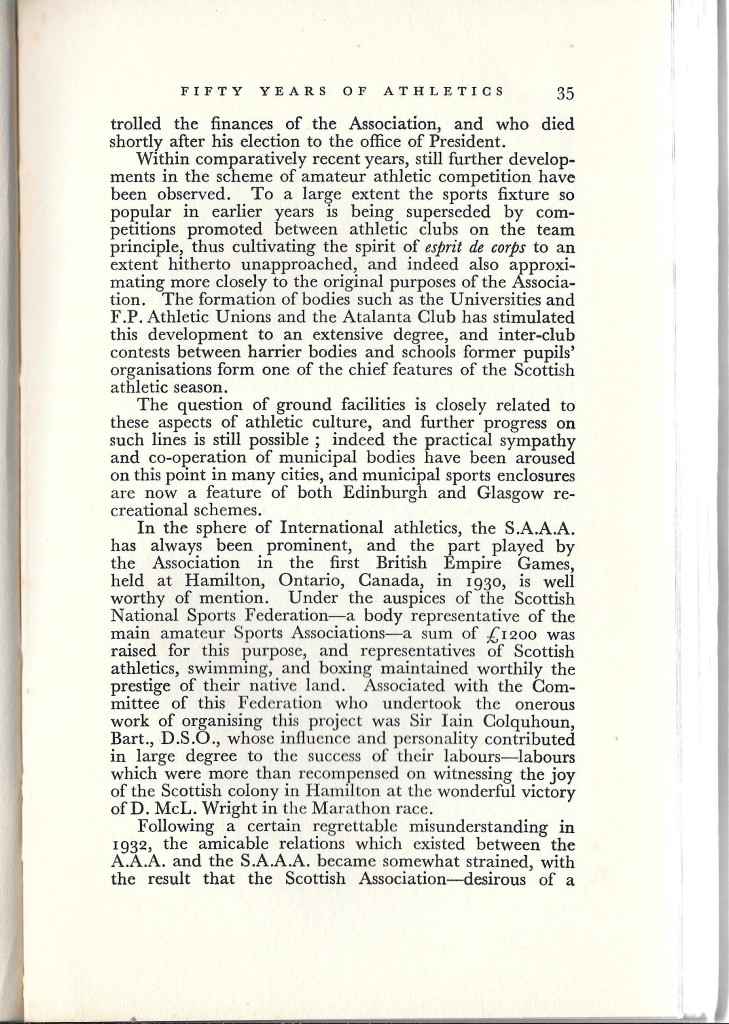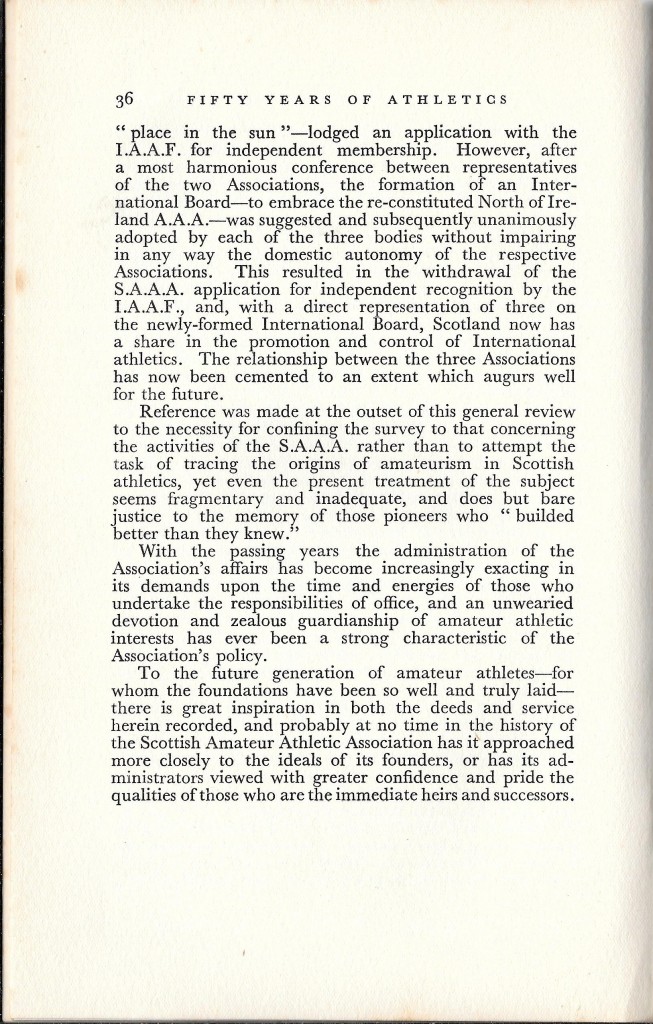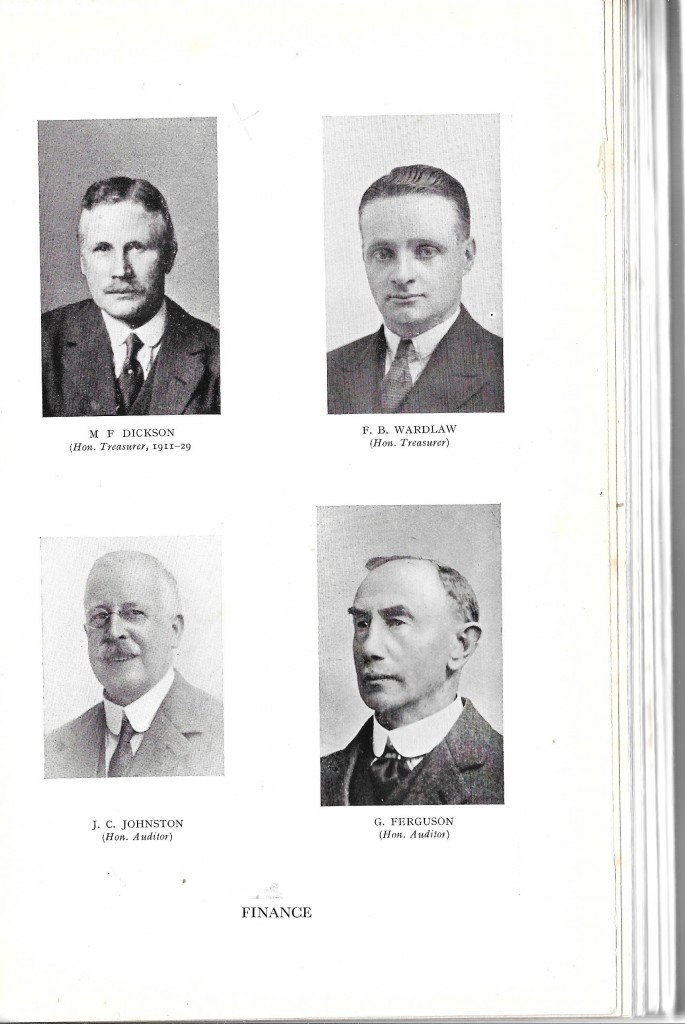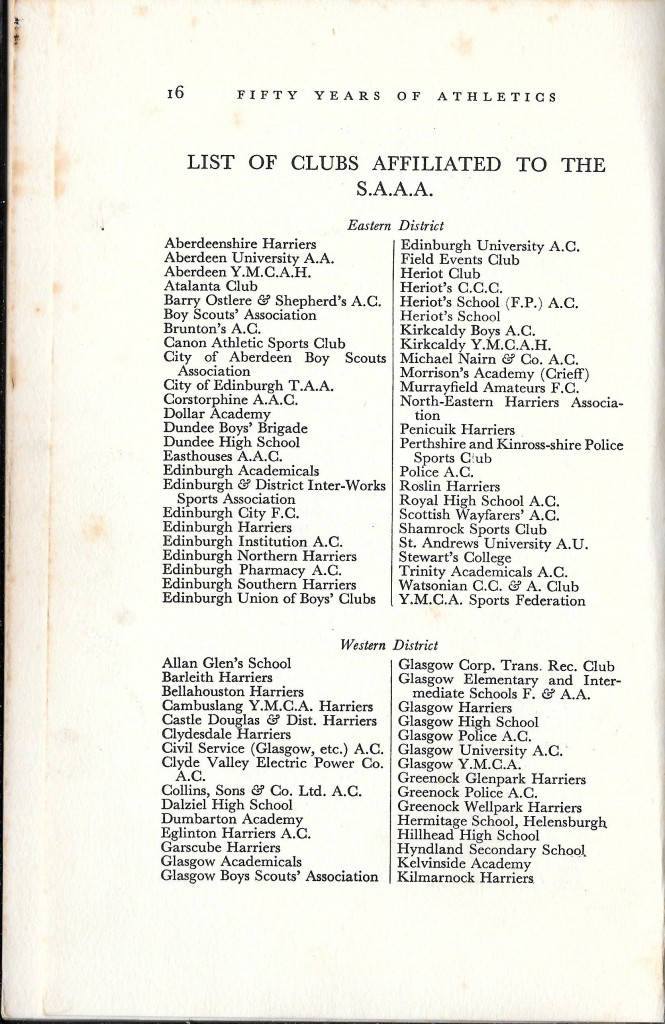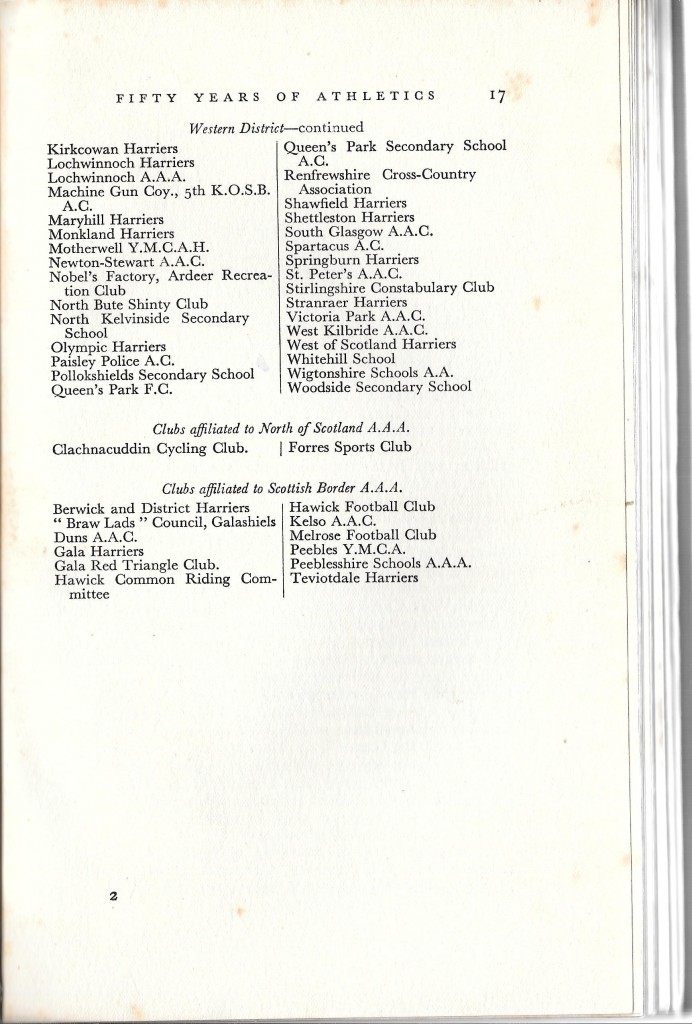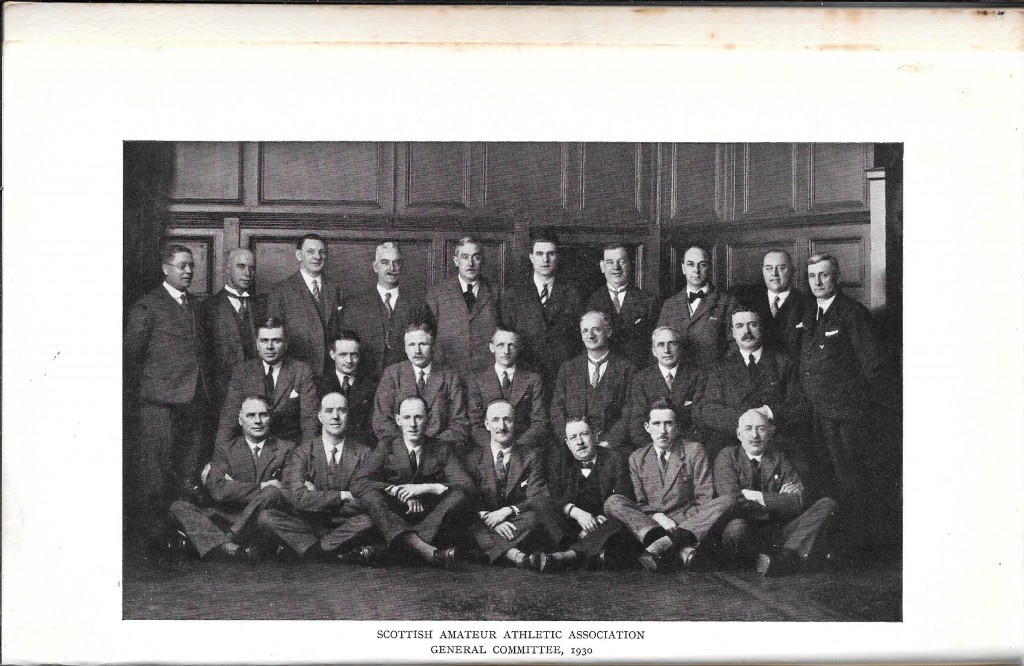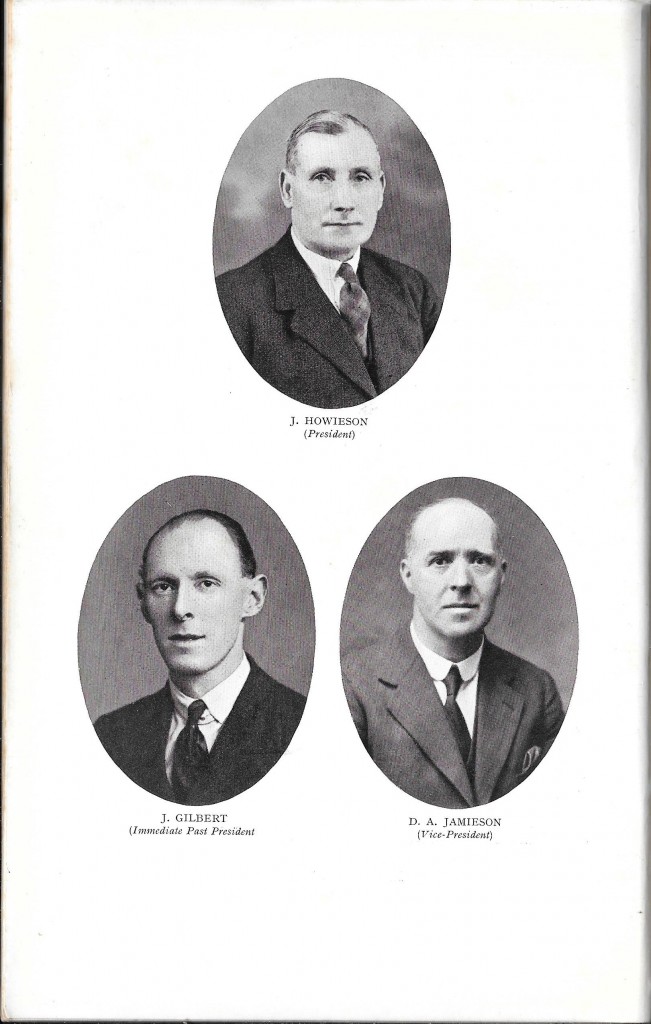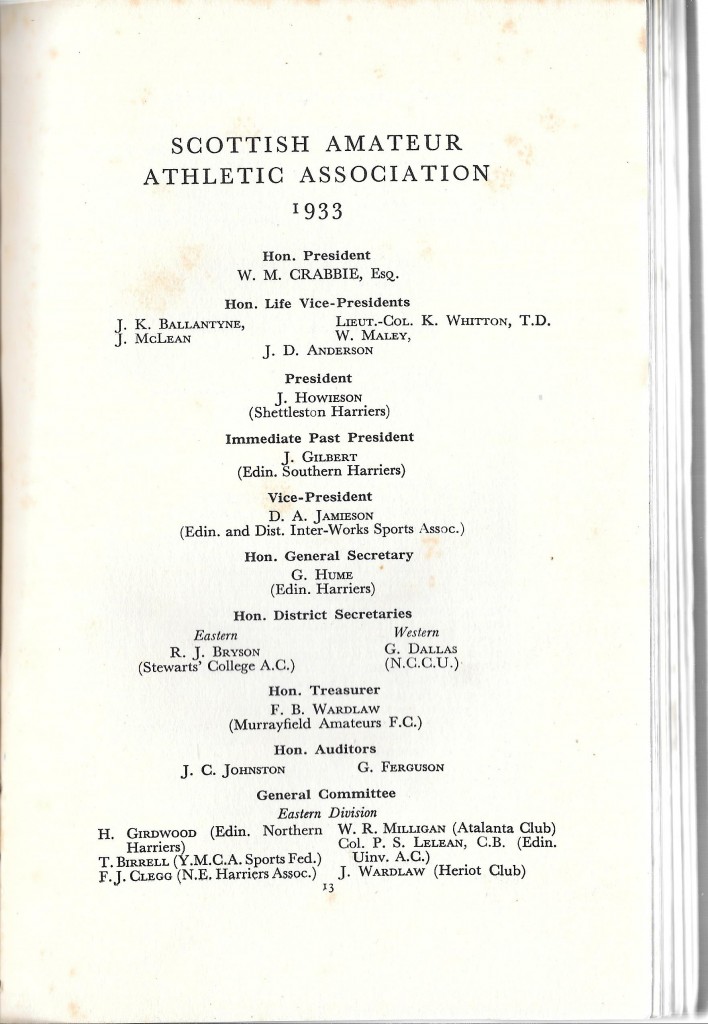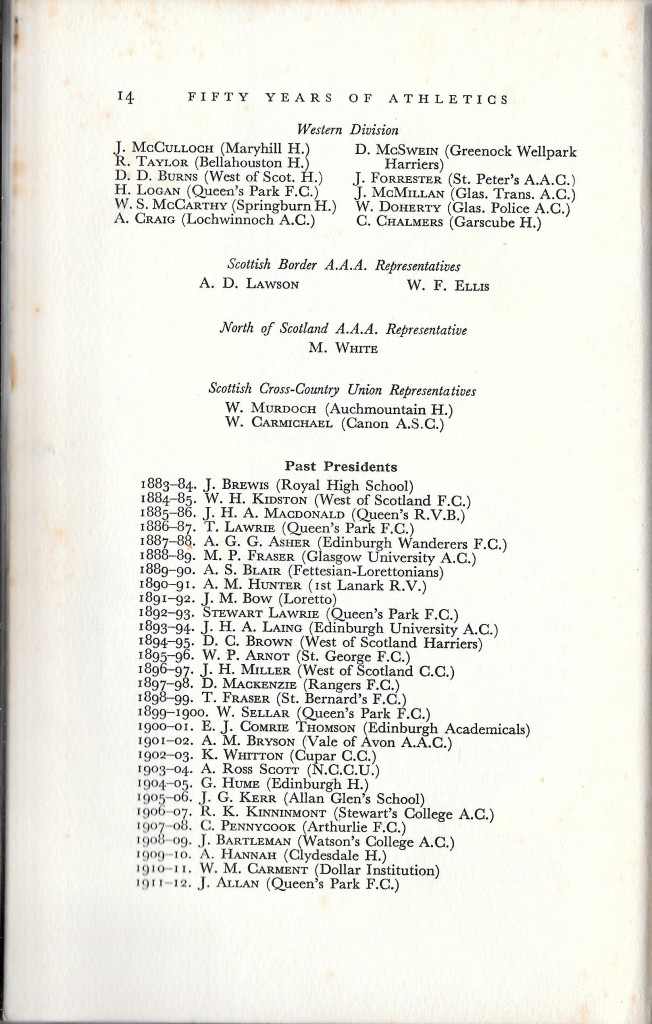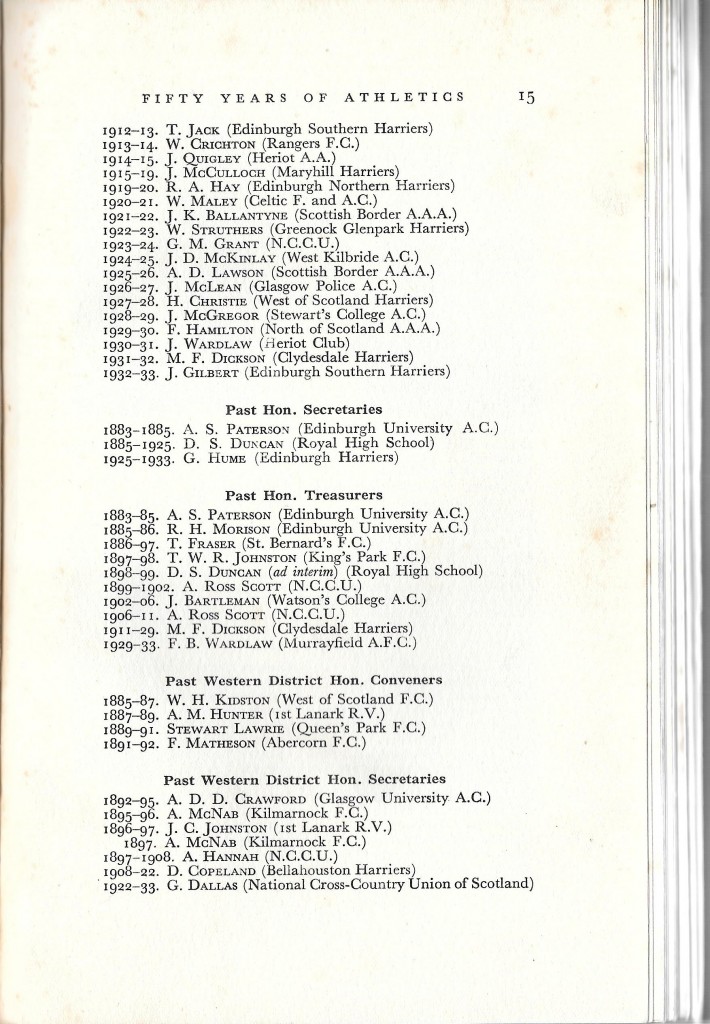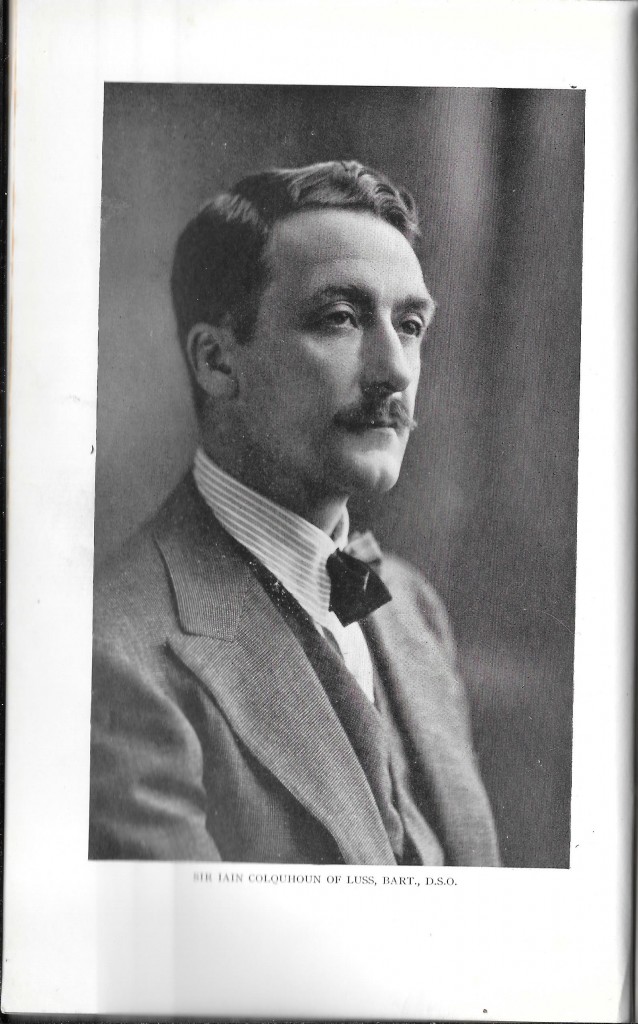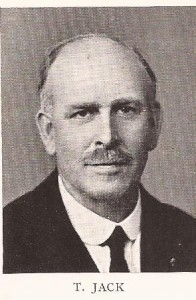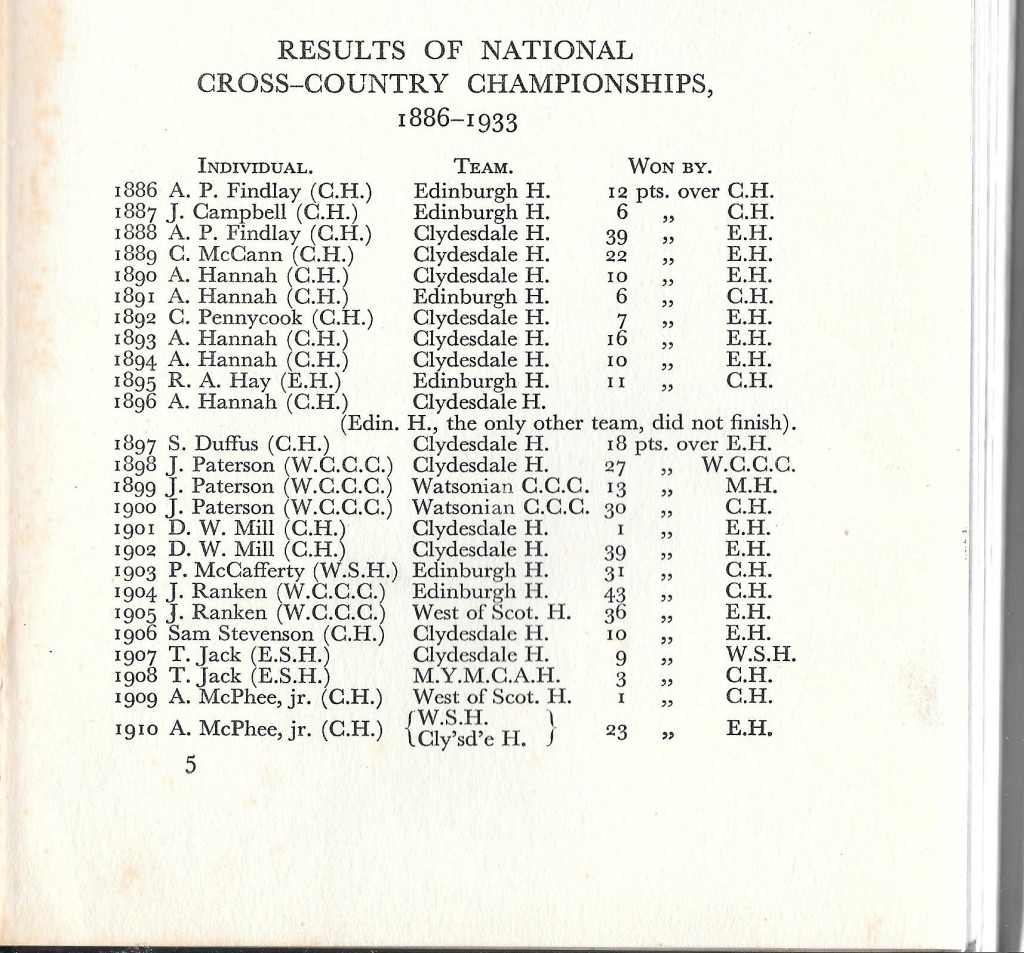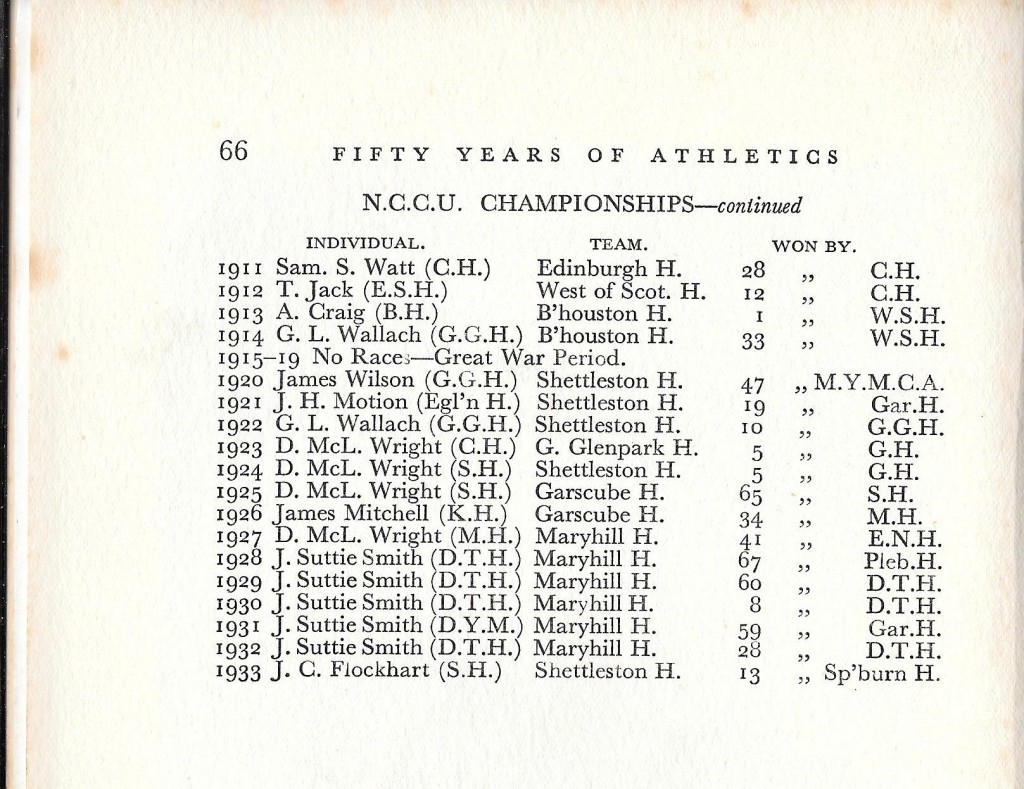Category: 50 Years of Athletics
David Scott Duncan: An Appreciation
David Scott Duncan who, for many years prior to his death was looked upon as the “father” of amateur athletics in Scotland, was born in Monkton House, Inveresk, where his father had farmed for many years. After a short term in Musselburgh Grammar School, he became a pupil in the Royal High School, Ednburgh, where he remained until he left for the University with a view to qualifying for a legal career.
While in the RHS, he was looked on as a sound scholar, and left with a very good grounding in Latin, Greek, English and French. He was proxime accessit for the India Prize, and in this competition he was awarded a soecial prize on account of the high standard reached.
While at school he competed successfully at the annual sports; but it was not until 1880 that he took up distance running seriously. During the following eleven years he won over 150 prizes, and in addition to winning the Scottish Mile Championship five times, he was runner-up three times and held for a short time the records for the two and three miles. He competed in the AAA Championships and, while never a winner, did faster time at Stamford Bridge than he had ever done in Scotland. His record for the mile race (4 min 28 sec) stood for some years.
After a short business career in Leith he became the Scottish representative of the Field and continued in this capacity till the Great War. He was a born journalist; his marvellous memory and intimate acquaintance with all branches of sport gave him a pre-eminent place in the journalistic world; indeed it could be truly said of him that in these islands for many years he stood without a peer in all round knowledge of athletics.
Two years after the founding of the SAAA he took over from Mr AS Paterson, Advocate – a distance runner of distinction – the duties of Secretary, and for the long period of forty years guided the destinies of the Association. His legal training, scholarship and , above all, his retentive memory fitted him in a high degree for the duties of Secretary, and whether in furthering the athletic contest with Ireland, or in conference with sister countries he worthily upheld the interests of his own.
He was a golfer of more than average ability, being a “scratch” player when he captained the RHS Golf Club, indeed, his method drew, on one occasion from a champion golfer and a friend of his own, the remark “Man, David, if you hit the ball on the back swing, you would be the longest driver in Britain!” For a time he was the captain of the Royal Musselburgh Golf Club. In the royal burgh by the sea members of the club still recal his eloquence, fine diction and humour when he presided at their annual dinner.
The Golfing Annual, of which he was editor, stands as a memorial to his research and hard work. In laying the foundation of this work he met most of the great golfers of his time, many of whom became his fast friends. But he was at hs best during the visits toIreland with the Scottish international team, and while always anxious for a Scottish win, never failed to congratulate an Irish opponent on a brilliant performance. As a time keeper and judge, he excelled, and one recalls his indignation when in 1908 at the Olympic Games in London and apparently pre-arranged attempt to shoulder Captain Halswell off the track in the memorable 400 metres race was made, and failed. It is no secret that in this race, which Duncan judged, it was he who broke the tape when he saw the foul, and “no race” was unanimously declared.
The sentiments of the writer, who met “DSD” for the first time in 1883, and those of his numerous friends, were well stated by an eminent member of the SRU: “He was one of the whitest men I ever knew.”
KW
Foreword
FOREWORD
In writing the foreword to Fifty Years of Amateur Athletics in Scotland, I am conscious of the value of the work both as a record of past endeavour and as a guide to future policy.
Our first introduction to athletics is generally gained at school, and it is interesting to remark the extraordinary progress that has been made in cultivating that fertile ground since the inception of the Scottish Amateur Athletic Association in 1883. At the present moment organised games and sports are as much an accepted feature of school curriculum as are arithmetic or history, and are generally admitted to be of equal importance.
There are those who consider that undue stress is laid upon the physical side of scholastic life, but for myself I cannot admit it. The average boy is full of a superabundance of energy which must find an outlet. If that energy be directed into a proper channel, it can be made a vital factor in the building of the boy’s character. If it be not so directed, it will find an egress in ways altogether undesirable. The Victorians visualised high spirits as a waste product, which must be eliminated by disciplined suppression. Our modern view teaches that boyish energy is a by-product of infinite value which can be used with results altogether beneficial, and that games and athletics supply that anchor-hold, that definite background during the critical period of adolescence without which the majority of us would give Satan a congenial task in finding “mischief still for idle hands to do”.
It is difficult to realise the extent to which sport I its many branches has influenced the character of the British nation. They have given to us, in my view, a balanced judgment, a complete immunity to panic, and a good humoured tolerance which must surely be the despair of the agitator and the revolutionary.
I hold that at the moment Great Britain is the only country where a natural democracy exists. Democracy demands a common meeting ground, a community of interest. Sport provides that, and I know of nothing that could take its place.
If we value flattery, then we may claim that the world has accorded us the sincerest form by imitating our methods, by accepting our standards and our valuations with an enthusiasm that we can only marvel at. What the effect on the diverse mentalities of other races than our own will be, we can only surmise, for national character is not formed in a generation. Perhaps the lessons they learned from sport will differ from those we have absorbed. However that may be, I feel they cannot be bad, but, on the contrary, must be good and beneficial in the highest degree. This book contains a record of Scotland’s contribution to the world of amateur athletics – and indeed it is not a small one. In it are names honourably known far beyond the Scottish borders, names of men in every walk of life, wh have upheld the high traditions of our race on the athletic field.
We can look in retrospect on that first meeting under Scottish Amateur Athletic Association rules, held in 1883, and trace the rapid growth and development in everything pertaining to the sport until the present day.
We cannot compare the champions of old with the present day athlete – and who wants to? Their times may have been greater and their distances less, but the conditions under which they competed were inferior in every respect. Let us, then, leave them that niche they ever hold in the memory f their countrymen; for their hearts were in the right place, which, indeed, is all that matters. In achieving the position that it holds today, the Scottish Amateur Athletic Association has had no easy road to travel, and all praise is due to those who have guided its destinies along the thorny path of control.
The Editors of this publication have earned the thanks of all Scottish sportsmen for their meticulous care in chronicling events of so great an interest, and for leaving us a record of the traditional and characteristic athletics of our country, and of those who gained fame in the fields of high endeavour.
IAIN COLQUHOUN
EDITOR’S NOTE
It has been truly written that “of the making of many books there is no end”, and in issuing this volume in commemoration of fifty years of activity in the administration and development of amateur athletics in Scotland, the Scottish Amateur Athletic Association adds itself to the increasing numbers of those who desire through the medium of the printed page to mark an important epoch in their life-story.
Owing to the loss of the minute books of the earliest years of the Association it is not possible to give a complete narrative of its origin; nevertheless an endeavour has been made to present a coherent story of its fifty years of existence. The Editors beg to acknowledge with gratitude the contributions made to this publication by Messrs W Reid (“Diogenes”), JK Ballantyne of Walkerburn, W Maley and WA Whitton, Inverness. Further acknowledgement is also gratefully made to athletic club officials and others for facilities given by them for the reproduction of many of the illustrations.
Especial thanks are also due to Messrs J Gilbert, T Jack, and J McCulloch (All ex-Presidents of the SAAA) for their valuable contribution to the compilation of the statistical section.
To those whose privilege irt is to gaze down through the mists of the past years this book may help to illumine the memories of their youth, whilst to those whose vision is directed towards the future may it prove a real inspiration to carry on a service so ably begun and to sustain a tradition so worthily created by their predecessors.
Kenneth Whitton
David A Jamieson
Joint Editors
Memories Of A Sports Promoter
MEMORIES OF A SPORTS PROMOTER
By William Maley
“Just by way of a foreword. This is not a biography. Business as usual still finds place in my itinerary. Tell how I got involved in athletics? A short story. Pride of place must be given to the lads of the village – Cathcart the village. You will notice that I am cutting out the hereditary stuff. We lads used up all our spare time of athletics. My strong suits were football, quoiting and running. I had even a short lived reputation as a cricketer.
One of the chiefs in my office further advanced me. He was a big noise in the Clydesdale Harriers – Andrew Dick. My all round abilities, no doubt, convinced him that I was a suitable subject for his club, which had fast been gaining fame for the infinite variety of its publications. I found myself among the starters for a junior cross country race. I enjoyed the novelty: was rather pleased at being placed. Despite the fact that I had touched wood and missed the water, I was soon able to walk normally.
To the track was the next command. On the Abercorn ground, Paisley, I appeared with other sprinters and carried off the prize. Cathcart was en fete that night – having no Band or Provost, neither turned out. Pot-hunting I have ever abhorred, so I confined myself to winning an odd prize here and there. As a matter of fact I kept on doing that sort of thing until one breezy afternoon I varied things by winning the 100 yards championship (SAAU). I mustn’t go ahead of the pistol. As I had been pushed into it, so I pushed my brother Tom, and right well he responded. He made his debut at the Queens Park Sports and collared the Open 100. That is how we celebrated the Jubilee Year (1887).
Celtic the new football club absorbed me and my time ever since. Hence the foreword. Why not sports for the new club? Why not, indeed! The MacLeans had their own boat, we will have our own sports. Hard work it was to convince the Committee, but ably backed up by my brother Tom and the late J.H. McLaughlin I succeeded. Some audacious deed was that. Our old enclosure at Dalmarnock Street was all right as a football ground, but as a sports holding enclosure it left much to be desired. Willing workers had made the ground; they did their best to produce a track. Certainly it did look well – so long as it was not used. It bore strong kinsmanship to a garden path. I am mindful of course that there were very few good tracks at that period. In the Western area, Hampden stood out as the best.
At Westmarch, Paisley, then St Mirren ground, Bob Hindle had brought the track to a pretty high state of perfection. Two Saturdays had been allotted for my first venture as sports promoter. Filling the bill was the next problem. The five-a-side stuff for junior and senior players was all right, so too the confined events for the players; but what of track events? Would the cyclists face the risks that our primitive track presented? Could we induce the cyclists to patronise our maiden effort? The answers were in the affirmative.
Just when the difficulty of apportioning the events had come into being, came a message of help from a good friend of mine in the Manchester area, a member of Salford Harriers. “’Sonny Morton, Kibblewhite and Parry will run at your preliminary meet if you can arrange an event.” “Arrange an event? Most surely; come along with them” was my reply. I am constrained to say that the visit of this famous trio was the forerunner of circumstances of like nature which made our sports the great feature they were. Great success were these runners. Morton’s wondrous finishing sprint simply carried the crowd off their feet and made the doubting Thomases on my committee have faith. A picturesque wee figure was Morton, and his colour scheme of green and gold delighted.”
So much for the first sports held at Celtic Park; the second were equally successful with Secretary being Willie Maley and Clerk of the Course Tom Maley. Reel forward to 1892.
“Our sports of 1892 were – well mammoth is the best term of description. I best remember them by the trick the weather clerk worked on us. Opened the day, sultry and warm. Trooped through the ‘stiles in their thousands the spectators. What a bill of fare was to be at their disposal! Out of the heat came an electric storm – as the Yanks call a severe lightning and thunder storm – mercilessly the clouds let loose their contents, and it was a badly soaked crowd which saw the sports from this intervention until the end. It was simply unbelievable the grip that the sports had on them, for despite the weather they waited to the end. No words are necessary to tell of the fare and the men – tribute enough was thus given.
I can never forget our first meeting on our present ground. Here is the bill of fare for the second. A galaxy of talent: Charlie Bradley, EC Bredin, FE Bacon, Geo. Crossland, Godfrey Shaw, AJ Gould, J King, C Pearce, Teddy Messenger, with the home talent supplying Alf Downer, DR McCulloch, Tom Donovan, A Hannah, S Duffus, H Barr, JR Gow, J Campbell, J Rodgers together with cyclists of the best type from all three countries.
I have set out to tell you how I came into the sports vortex as competitor and as sports promoter. My appearance as legislator and President I may not tell, that is with the members of the SAAA.
If in such capacity I fell short, or in any way lacked the brilliance of former occupants of that high office, I can at least claim that gave of my best for the best and for the general good of amateur athletics.”
Cross Country Running in Scotland
The Inter-Scholastic Games
“To the present generation the following details – given by way of introduction – may prove interesting. Traces of the origin of the Inter-Scholastic Games are to be found in the early reports given of the “Edinburgh University-School Games”. In a descriptive account given of one such meeting, one reads: “The scene was particularly pleasing, large marquees being erected on the sports ground, each flying the colours of the schools whose representatives were striving to maintain their athletic traditions on the grassy area nearby.”
These “athletic traditions”, be it noted, date back many years before the founding of the SAAA. Indeed it is probable that the founders of the Association gained inspiration from this sports meeting held uder University auspices hard by Corstorphine in the ‘seventies of last century, and in which the competitors still preserved the associations of their schools, such as Merchiston, Loretto, Fettes, Blair Lodge, etc.
Later with changing conditions, the Schools featured no longer in the Varsity Sports. As a separate promotion the Inter-Scholastic Games had a chequered existence, and after languishing for a few years in an atmosphere of apathy they disappeared from the sports calendar in 1885. An attempt to revive their former glory was made five years later (1890) but met with little success.
It was not until 1890 that Mr EJ Comrie Thomson, then President of the SAAA, stimulated by the enthusiasm of Mr DS Duncan, the Hon Secretary, succeeded in inaugurating the present series of the Games. No break has occurred since that year, although endeavours have been made from time to time to discontinue the Games on two grounds: (1) That they did not fulfil their object of introducing schoolboy competitors to senior athletics; and (2) That the yearly deficit incurred by the Games was too heavy to be borne by the Association’s finances.
When one recalls such names as LJ Dunn, J Crawford, T Riddell JG McColl, RD Allison, AM Murray, AF Clark, JB Bell, in connection with Inter-Scholastic honours, the first contention of the above arguments seems disproved, while the financial burden incurred must be regarded as a necessary expenditure in the best interests of amateur athletics.
On the suggestion of JG Ker, LLD, an ex-president of the Association, the Schools Championship feature was omitted from the scheme of competition in 1906. Later, in 1912, Mr C Symington, Stewart’s College, was successful in his proposal to raise the third grade of the competition from 13 years to 14 years, at which it still remains.
The practice of athletics is an item in the scholar’s curriculum which has developed to an extraordinary degree during the last ten years, and the standard of merit attained by many of the schoolboys in the highest grade at times approaches that obtaining in senior athletics, as a glance at the returns given on the following pages will show.”
[ Inter Scholastic Champions ]
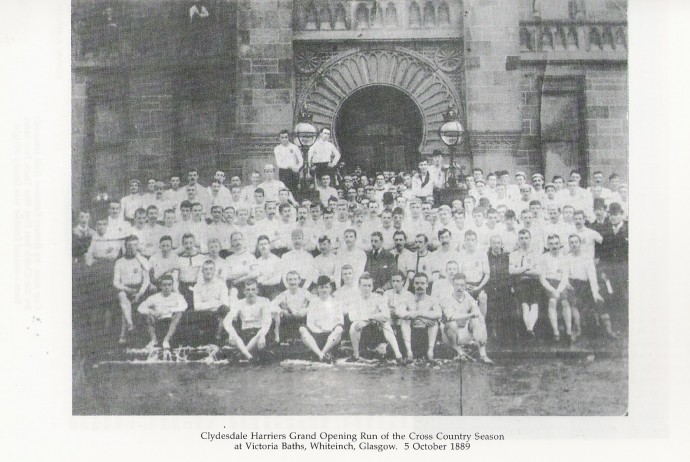
The Origins of Cross Country Running in Scotland
The above picture is of the Clydesdale Harriers Opening Run which opened the Whiteinch Baths in Glasgow in 1989.
“Cross-country running in Scotland, as we know it today, began with a meeting which was held in Glasgow on May 4th, 1885, at which it was decided to form a club to be known as the ‘Clydesdale Harriers’. Previously some of the Scottish public schools had held occasional ‘paper-chases’ but although there were plenty of athletes competing at sports meetings in the summer months, the winter months were allowed to pass in idleness, except by those who played football. While waiting for the cross-country, the C.H. ran off several handicaps on the track at Kinning Park, the old ground of the Rangers FC.
The first cross-country run was held in Milngavie in September 1885. On that occasion the ‘hares’ were very strong and covered a distance of thirteen miles, running for nearly two hours. On 30th September 1885 the late DS Duncan called a meeting in Edinburgh at which the Edinburgh Harriers club was brought into being and in November 1885, an inter-club run was held at Coltbridge, Edinburgh. During the winter of 1885, the Lanarkshire Bicycle Club and the Langside Bicycle Club formed harriers sections but they found the sport too strenuous and the sections faded out. In December of that year the Edinburgh Harriers held the first cross-country handicap ever held in Scotland over a distance of four miles. DS Duncan and WM Gabriel ran off scratch with a handicap limit of four minutes.
In February 1886, an inter-club between the Edinburgh Harriers and Clydesdale Harriers was held at Govan when a field of twenty seven runners took part! At the convivial gathering which followed, DS Duncan made a strong appeal on behalf of the SAAA for further support for that body.
The first Scottish Cross-Country Championship was held on Lanark Racecourse. It was a challenge match between the CH and the EH. The venue was unsuitable for the CH, and out of fourteen nominations only four contested the race. The EH had seven men forward. AP Findlay (by far the oldest runner in the field) won from DS Duncan, who was at that time considered the best long distance athlete in Scotland. Findlay was a stone-mason to trade, and a very hardy athlete. When the news reached Ayr (his home town), preparations were made to greet him on the arrival of his train at 9:12 pm. He did not turn up and a still larger crowd met the 11:20 pm train, but again there was no Findlay. At 7:40 on the Sunday morning he arrived footsore and weary having walked from Barrhead to Kilmarnock to catch the mail train for Ayr. He had no special preparation for the race which had been arranged only three weeks before it was run. There are only two survivors of those who competed in this first championship – John Clelland of Larkhall and James Campbell of Helensburgh – both of whom ran in CH colours.
When Findlay won again in 1888 all the runners went off the trail, and Findlay was blamed (probably unjustly) for leading the field astray. He could keep going indefinitely and the competitors ran about sixteen miles that day – some arriving back in cabs and other conveyances. One or two had to have their shoes cut off in the main street of Ayr, and finished barefooted in the snow and slush and darkness.
In September 1886 the West of Scotland Harriers Club was formed, the membership of which at the beginning was mostly composed of cyclists and rowing men.
Outside of the three principal clubs – the CH, EH and WSH – the sport did not make much progress for the first couple of years, and it was only when the CH started to develop branches, or sections, in different parts of the country that it began to take hold. Sections were formed in different towns in Dumbartonshire, Stirlingshire, Renfrewshire, Lanarkshire and Ayrshire, and these were carefully nursed by the parent body. When the sections were strong enough to stand alone, they formed themselves into separate clubs and so the movement spread. The pioneer work was very exacting, but the founders had great faith in the future of the sport, and the result justified their efforts. It is of interest to mention that in the CH the whipper-in of the main pack carried a hunting horn slung over his shoulder and made appropriate noises with it during the course of the run.
Not till the season of 1887-88 did the real missionary work begin. With the advent of Andrew Dick as Joint Secretary things began to hum. When James Erskine took office in 1888 the CH membership had risen to about 200, and in 1900 it went up to 1000 paying members, who had the benefit of a private club-room in Dundas Street, Glasgow, where runners could meet at any time and get all the athletic and other newspapers as well as a manuscript magazine (monthly) run by Clydesdale’s own members. There was in addition a gymnastic and boxing section, with premises at Garnethill. Mr Erskine still takes a lively interest in the affairs of the sport.
The two chief protagonists of cross-country running in the early days were Andrew Dick in the West and DS Duncan in the East. Another survivor of the first season, 1885-86, is TW Young (CH). Although a sprinter of much ability on the track, Young seldom missed a run across country.
In season 1890-91 Andrew Hannah (CH) was champion. He had a stern opponent in Wm Thomson (CH) of Larkhall, a well-known runner on the track. ‘Big Wull’ was a forester for many years on the Hamilton Ducal Estates. Popular wherever he went, he is now resident in Paisley. Hannah is still hale and hearty and located in the city of St Mungo.
Missing a sequence of years we now come to that well known schoolmaster, Tom Jack (ESH) who won in 1907-08 and again in 1912. Mr Jack is still very much to the fore, and now discharges his duties as Eastern District Handicapper with characteristic thoroughness.
The years 1922-3-4 brought out that wonderful distance runner, Duncan MacLeod Wright. In 1922 he ran in the colours of the CH and in 1923 and 1924 in those of Shettleston Harriers. He is however perhaps better known under the Maryhill colours. Two of his greatest honours were the victories in the AAA Marathon (Windsor to Stamford Bridge), 1924, and the Empire Marathon Championship (1930), (Hamilton, Ontario). One cannot overlook the brilliant performances of J Suttie Smith who was five times champion in the sequence of years 1928 – 1932 inclusive. Surely this will be a record that will be difficult to equal, let alone excel.
What is one to say of the present champion, only a novice of recent discovery? JC Flockhart (Shettleston Harriers) has set the whole athletic universe talking. To win the Midland, Junior and National Championships in one year is indeed something to be proud of. Veterans predict a brilliant future for this youth, who like many of the veterans of the past, has raised the level of cross-country running in Scotland to an international standard.”
Next: Statistics: SAA Championships
